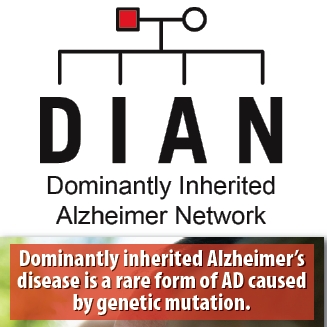
July 20, 2011: Inherited forms of Alzheimer’s disease may be detectable as many as 20 years before problems with memory and thinking develop, scientists will report July 20, 2011, at the Alzheimer’s Association International Conference on Alzheimer’s Disease in Paris.
Identifying Alzheimer’s in its earliest stages is a top priority for researchers. Many think that by the time symptoms become apparent, Alzheimer’s disease has already damaged the brain extensively, making it difficult or impossible to restore memory and other mental abilities.
 “We want to prevent damage and loss of brain cells by intervening early in the disease process — even before outward symptoms are evident, because by then it may be too late,” says Alzheimer’s researcher and physician Randall Bateman, MD, of Washington University School of Medicine in St. Louis and an associate director of the Dominantly Inherited Alzheimer’s Network (DIAN), an international study of inherited forms of Alzheimer’s.
“We want to prevent damage and loss of brain cells by intervening early in the disease process — even before outward symptoms are evident, because by then it may be too late,” says Alzheimer’s researcher and physician Randall Bateman, MD, of Washington University School of Medicine in St. Louis and an associate director of the Dominantly Inherited Alzheimer’s Network (DIAN), an international study of inherited forms of Alzheimer’s.
Initial DIAN results confirm and expand upon earlier insights from studies of the more common sporadic forms of Alzheimer’s, including data suggesting that changes in the levels of biological markers in the spinal fluid can be detected years before dementia.
Scientists say the results demonstrate the feasibility of clinical trials to prevent Alzheimer’s in DIAN participants. Planning for those trials, which may start as early as next year, is currently under way.
“New treatments may have risks, so to treat patients prior to symptoms we must sure that we have a firm grasp on who will develop Alzheimer’s dementia,” says DIAN director John C. Morris, MD, Harvey A. and Dorismae Hacker Friedman Professor of Neurology at Washington University. “If we can find a way to delay or prevent dementia symptoms in DIAN participants, that would be a tremendous success story and very helpful in our efforts to treat the much more common sporadic form of the illness.”
DIAN researchers are studying members of families who have mutations in one of three genes: amyloid precursor protein, presenilin 1 or presenilin 2. Participants with these mutations are certain to develop Alzheimer’s disease early, with symptoms beginning in their 50s, 40s, or, in some rare cases, 30s.
DIAN, which includes research centers in the United States, the United Kingdom and Australia, is the largest study yet of these rare forms of dominantly inherited Alzheimer’s. To date, 184 participants have been enrolled, nearly half the overall recruitment goal. This has allowed initial comparisons among participants who carry a genetic mutation for Alzheimer’s but are still asymptomatic, those who have a mutation and have Alzheimer symptoms, and those who do not have a mutation and thus are unaffected.
By looking at the age of symptom onset in a parent who passed an Alzheimer’s mutation to a DIAN participant, scientists can establish an estimated age of onset for a study participant. If a parent developed dementia at the age of 50, they would expect a child who inherited the mutation to develop dementia at roughly the same age. As a result, scientists can start amassing a detailed chronology of disease progression that covers the many years Alzheimer’s is active in the brain but still before the onset of dementia.
“Based on what we see in our population, brain chemistry changes can be detected up to 20 years before the expected age of symptomatic onset,” Bateman says. “These Alzheimer’s-related changes can be specifically targeted for prevention trials in patients with inherited forms of Alzheimer’s.”
Washington University researchers, including Bateman, Morris and Anne Fagan, PhD, research professor of neurology, will report initial results from DIAN, including confirmation of the value of disease indicators from cerebrospinal fluid analyses. Participants who carry the mutations but are still asymptomatic have significantly lower levels of amyloid beta and higher levels of tau protein in their cerebrospinal fluid than participants without the mutations.
Amyloid beta normally is cleared from the brain and into the spinal fluid. Scientists theorize that decreases in spinal fluid levels of amyloid beta reflect a buildup of this sticky protein fragment in the brain, where it forms Alzheimer’s plaques. Tau protein is a structural component of central nervous system cells. Its increase in cerebrospinal fluid is thought to be a byproduct of damage to brain cells.
###
DIAN is supported by funding from the National Institute on Aging.
Washington University School of Medicine’s 2,100 employed and volunteer faculty physicians also are the medical staff of Barnes-Jewish and St. Louis Children’s hospitals. The School of Medicine is one of the leading medical research, teaching and patient care institutions in the nation, currently ranked fourth in the nation by U.S. News & World Report. Through its affiliations with Barnes-Jewish and St. Louis Children’s hospitals, the School of Medicine is linked to BJC HealthCare.

